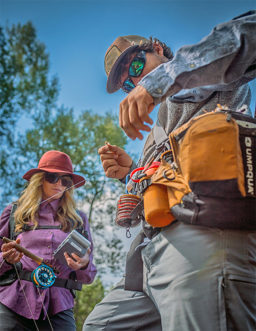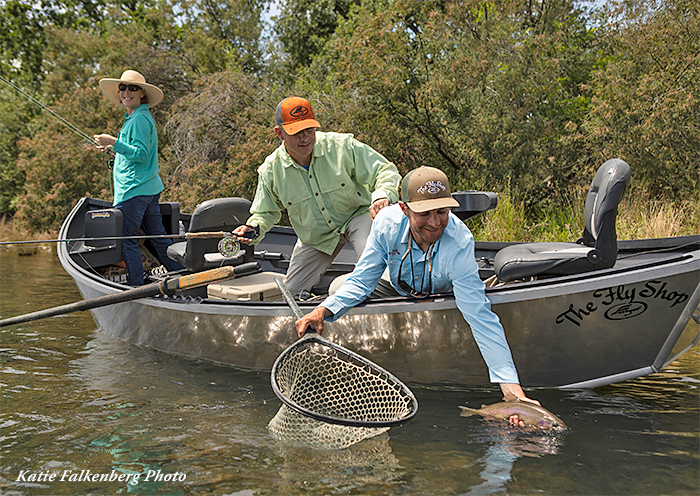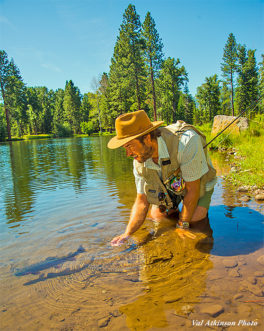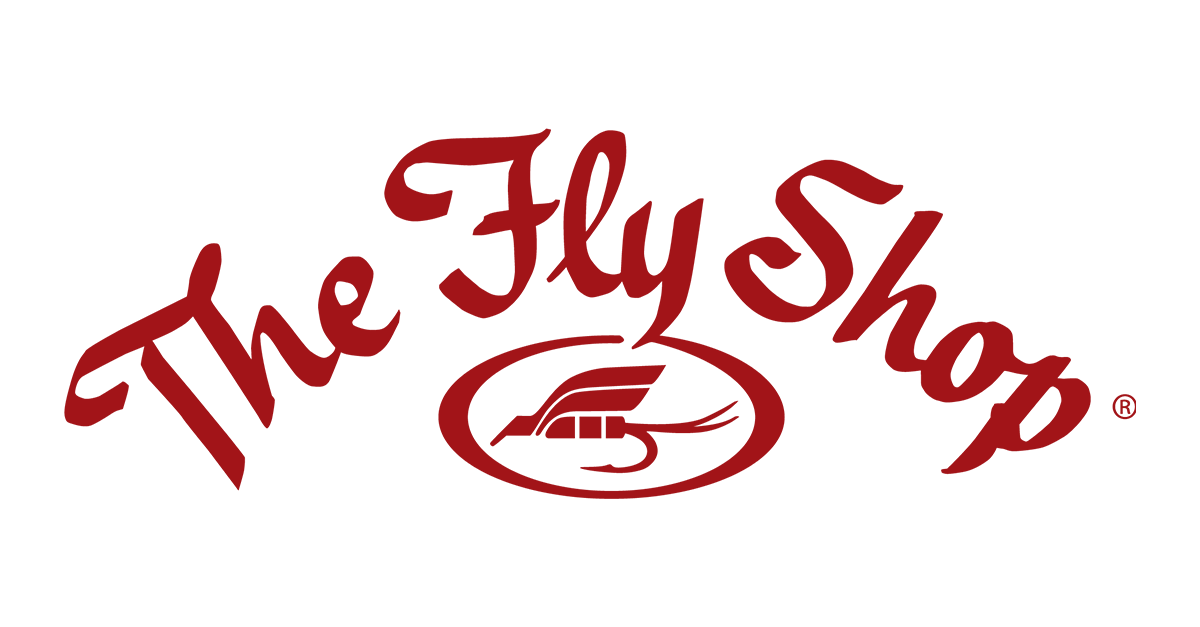Simple Tips for Fly Fishing in the Summer Heat
As we come roaring into summer here in NorCal, with several days tipping past the 100-degrees mark, we need to start changing some of our fishing techniques to protect trout. Normally in June our trout streams begin warming up, causing a corresponding decrease in the amount of oxygen in the water. As water gets warmer the “saturation concentration” of oxygen gets lower – in other words, the warmer the water, the less oxygen it can hold. Therefore, when water temperatures increase, fish are often hit with a double whammy of low oxygen and warm water, both of which make them more susceptible to stress and fatigue. During these times of low, warmer flows, it’s critical that we adjust how we fight fish and handle them once landed.
 Many of us in fly fishing love to use the lightest tippet we can – this not only adds to the challenge of landing a nice trout, but it usually results in more eats, as well. However, using light tippet also adds time to the fight. In warm water, this is a killer on trout, no matter how well you revive them for a solid release. Going up one or two sizes in tippet allows you to land your fish quicker and not exhaust it to a distressed state beyond its ability to recover. Because warmer water has less oxygen and prolonged fights exhaust fish, landing them as quickly as possible is the responsible thing to do. And there are even times when the water is just too hot to fish. Imagine suffering from pneumonia, struggling for breath, then being forced to run a 100-yard dash. We know the water is shallower and clearer during the summer, and light tippets seem to be the answer for more success – but to the unacceptable detriment of the fish. Think conservation here, not merely success … as Lee Wulff said, “Gamefish are too valuable to be caught only once.”
Many of us in fly fishing love to use the lightest tippet we can – this not only adds to the challenge of landing a nice trout, but it usually results in more eats, as well. However, using light tippet also adds time to the fight. In warm water, this is a killer on trout, no matter how well you revive them for a solid release. Going up one or two sizes in tippet allows you to land your fish quicker and not exhaust it to a distressed state beyond its ability to recover. Because warmer water has less oxygen and prolonged fights exhaust fish, landing them as quickly as possible is the responsible thing to do. And there are even times when the water is just too hot to fish. Imagine suffering from pneumonia, struggling for breath, then being forced to run a 100-yard dash. We know the water is shallower and clearer during the summer, and light tippets seem to be the answer for more success – but to the unacceptable detriment of the fish. Think conservation here, not merely success … as Lee Wulff said, “Gamefish are too valuable to be caught only once.”
So, once you land a beautiful fish, how can you help reduce mortality? The best (only) way is to keep the fish in the water. Period. If you need to get that photo to commemorate your catch, make sure you keep the fish wet and two inches above the water for no more than a few seconds at a time and get that picture quickly. The picture should show dripping water off the fish. Holding a fish out of water is like holding your head under water – it makes breathing impossible. You can always forgo the grip-and-grin, keeping the fish in the water to start the release process.

When releasing the fish, don’t just throw it back with the expectation that it will swim away unharmed. It won’t; in fact it will often die, especially during hot summer days. Actually, you should never literally throw a fish back, as it’s disrespectful to the fish and could cause shock and/or injury. Instead, if you remove it from the water, immediately and gently get the fish back into the current, pointing its head upstream, allowing the water to flow through its mouth and over the gills. Make sure the fish is in fighting shape before you let it go. It should actually swim out of your hands when it is revived and ready to go. This may take a few minutes and several false starts of the fish before it is strong enough to swim away on its own. Please don’t aggressively move the fish back and forth in the water as the backward movement forces water into its gills from behind, which is akin to having the wind knocked out of you.
 When fishing stillwaters, pay attention to the water temperatures in the shallows. If you are fishing from the shore, with no current and strong sunshine, temperatures can skyrocket as the day progresses, making a deathtrap for an oxygen starved fish. Be prepared to wade out into cooler waters to revive your fish. A great technique is to place the fish in your net and extend it out into deeper water. Long handled nets work great for this. Let the fish resuscitate in the net; you may have to help right it. When it’s ready it will let you know.
When fishing stillwaters, pay attention to the water temperatures in the shallows. If you are fishing from the shore, with no current and strong sunshine, temperatures can skyrocket as the day progresses, making a deathtrap for an oxygen starved fish. Be prepared to wade out into cooler waters to revive your fish. A great technique is to place the fish in your net and extend it out into deeper water. Long handled nets work great for this. Let the fish resuscitate in the net; you may have to help right it. When it’s ready it will let you know.
Tips:
- Fish deep riffles and fast water, often at the head of pools where the elevation drop of water is greatest and where the water may have more oxygen. This is where most of the fish will tend to congregate during warm water conditions.
- Ditch your standard monofilament tippet in favor of fluorocarbon when nymphing. Fluorocarbon allows you to fish stronger, less visible, more abrasion-resistant tippets with a smaller diameter, which in turn allows you to land trout faster and with reduced stress, particularly in warm water situations.
- Consider using a landing net (with a fish-friendly, rubberized basket) to reduce handling and to land the fish quicker. Waiting for it to tire so you can bring it to hand only increases stress on the fish and the mortality rate.
For more information, check out this interesting and informative article by our friends at Trout Unlimited – FISH STRESS FROM CATCH-AND-RELEASE FISHING.
Click this link for examples of basic catch and release skills to learn and practice – SKILLS FOR BASIC CATCH-AND-RELEASE TROUT UNLIMITED


